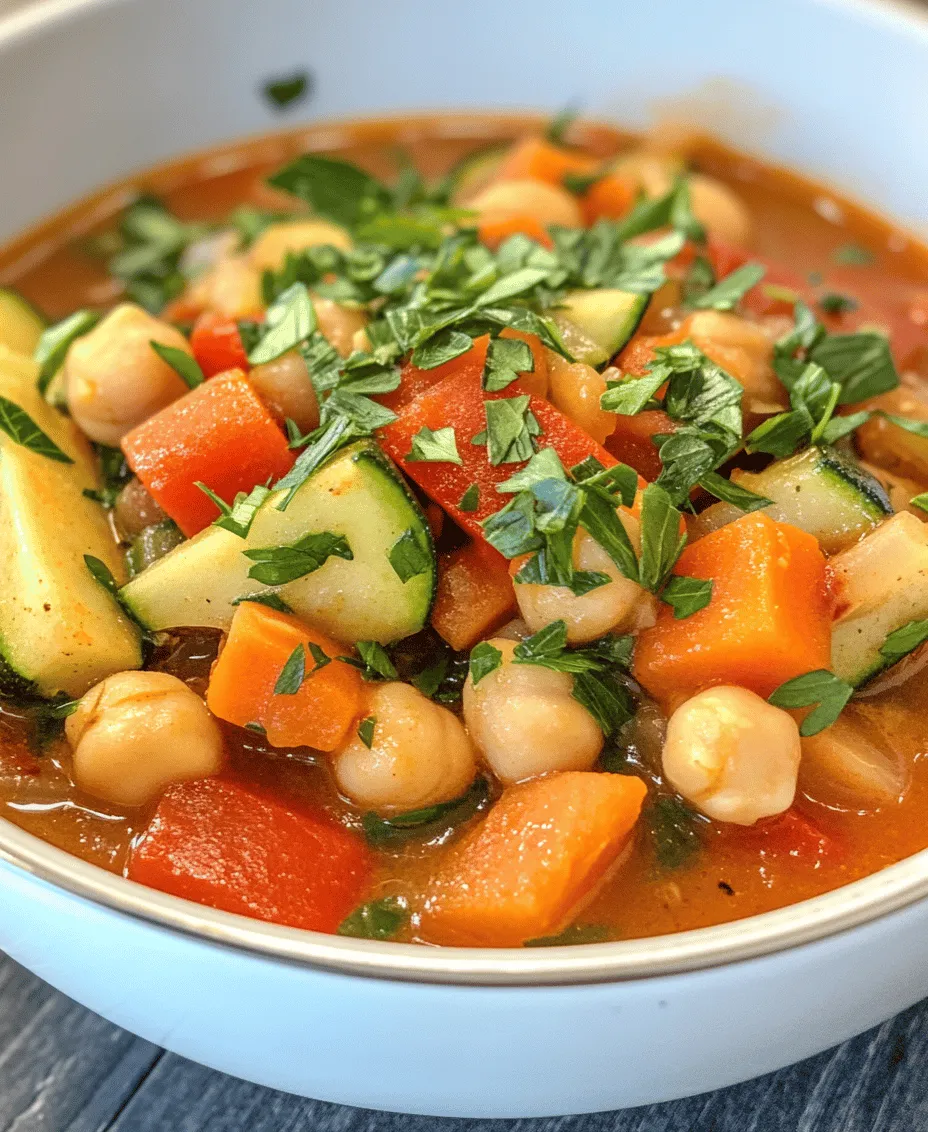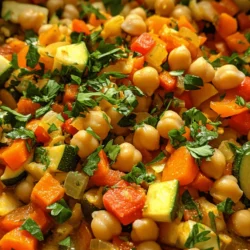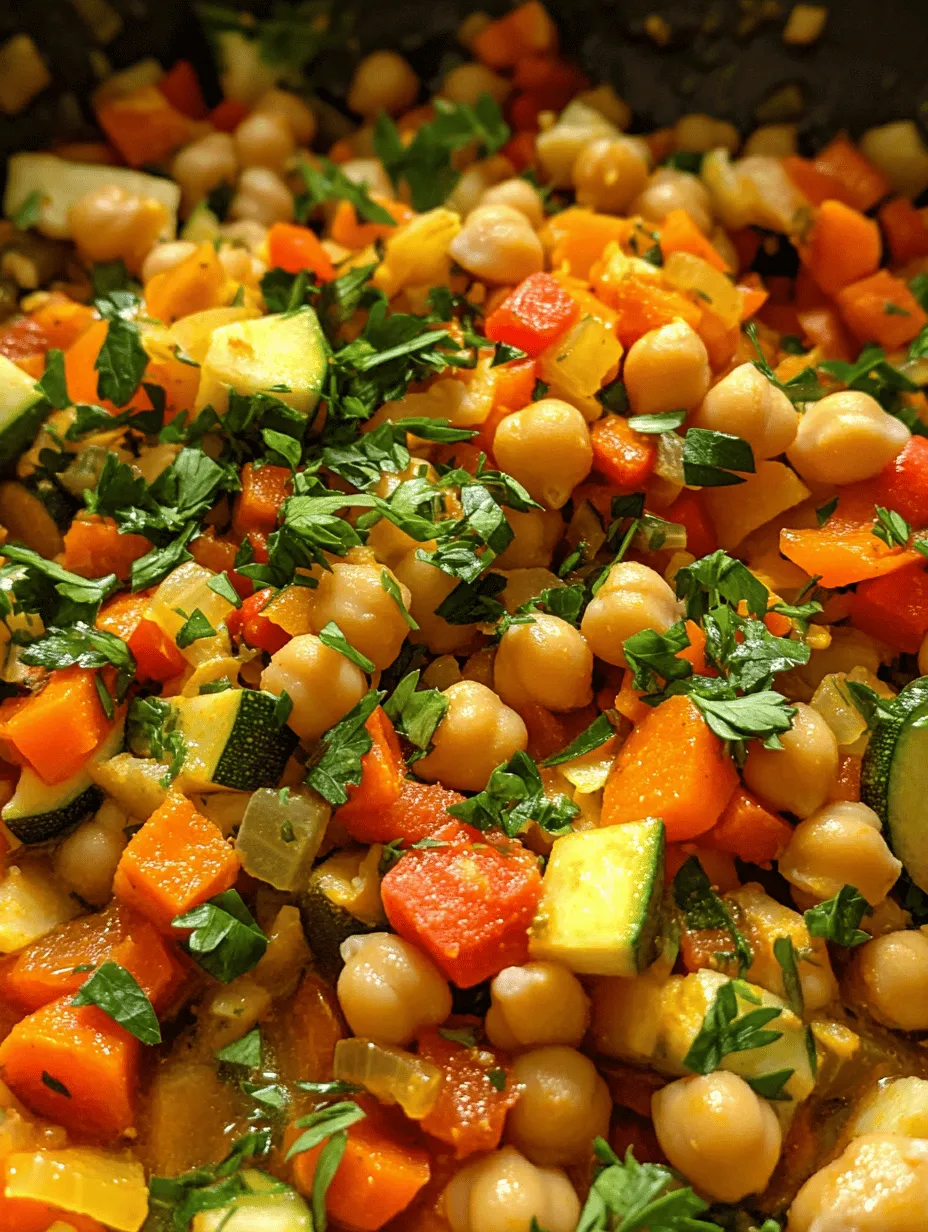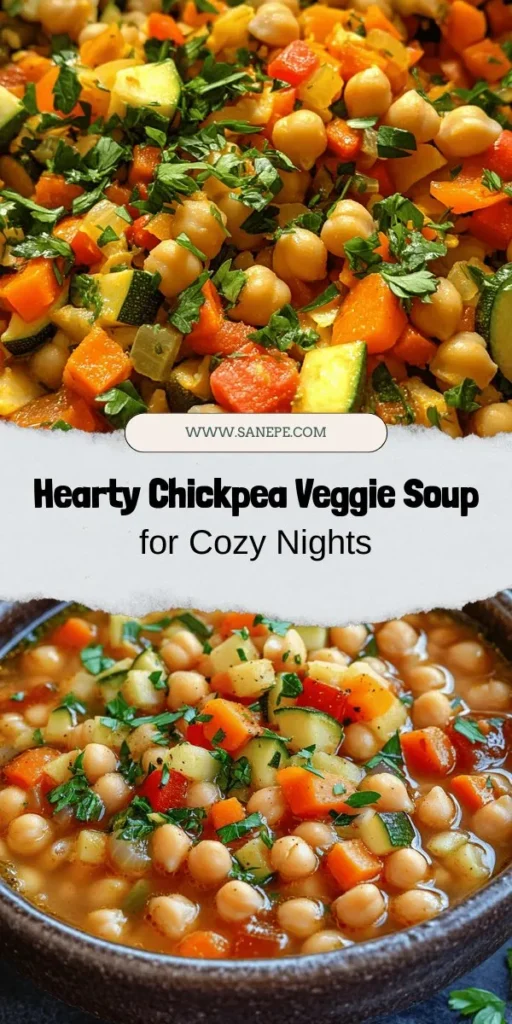Introduction
As the weather cools down and the days grow shorter, there’s nothing more comforting than a warm bowl of soup. Enter the Comforting Chickpea & Veggie Soup with Ditalini—a hearty and nourishing dish that not only warms the soul but also excites the palate. This soup is a delightful medley of wholesome ingredients, featuring protein-packed chickpeas, vibrant vegetables, and tender ditalini pasta, all simmered to perfection in a rich broth.
The beauty of this recipe lies in its simplicity and adaptability. It’s a versatile dish that can be enjoyed year-round, whether you’re seeking a nourishing meal to combat the winter chill or a light yet satisfying option for a spring evening. Packed with nutrients and flavor, this comforting soup is a fantastic addition to any meal rotation, especially for those following a plant-based lifestyle.
The Nutritional Benefits of Chickpeas and Vegetables
Chickpeas, the star ingredient of this soup, are renowned for their impressive nutritional profile. Rich in protein and dietary fiber, they provide a satisfying fullness that keeps you energized throughout the day. A single cup of cooked chickpeas contains about 15 grams of protein and 12 grams of fiber, making them an excellent choice for anyone looking to boost their protein intake without relying on animal products.
Beyond their protein content, chickpeas are loaded with essential nutrients, including iron, magnesium, and folate. These nutrients play a vital role in supporting overall health, from promoting healthy digestion to aiding in energy production. Incorporating chickpeas into your diet can help maintain blood sugar levels and promote heart health, making them an ideal ingredient for anyone looking to enhance their nutrition.
In addition to chickpeas, this soup features a colorful array of vegetables, including carrots, zucchini, and bell peppers. Each of these veggies brings its own unique set of vitamins and minerals to the table. Carrots are an excellent source of beta-carotene, an antioxidant that supports eye health and boosts the immune system. Zucchini adds a refreshing flavor and is rich in Vitamin C, which helps protect the body against free radicals. Bell peppers, especially the vibrant red and yellow varieties, are loaded with Vitamin A and Vitamin C, contributing to skin health and overall vitality.
Using fresh ingredients not only enhances the flavor of this soup but also maximizes its nutritional benefits. Fresh vegetables retain more nutrients than their canned counterparts, ensuring that you receive the fullest extent of their health-promoting properties. Choosing high-quality produce makes a significant difference in the overall taste and nutritional value of your dish, transforming a simple soup into a truly nourishing meal.
Ingredients Breakdown
To create this Comforting Chickpea & Veggie Soup with Ditalini, you’ll need the following ingredients:
– Chickpeas (canned or cooked): A staple in Mediterranean and Middle Eastern cuisines, chickpeas are the primary source of protein in this recipe. Their nutty flavor and creamy texture make them the perfect complement to the other ingredients.
– Ditalini pasta: This small, tube-shaped pasta is ideal for soups, as it holds onto the broth and flavors beautifully. You can substitute it with gluten-free pasta if needed.
– Carrots: Diced carrots add sweetness and texture to the soup while providing essential vitamins.
– Zucchini: This versatile vegetable adds a mild flavor and blends seamlessly with the other ingredients.
– Bell peppers (red, yellow, or green): Sliced bell peppers contribute a crunchy texture and vibrant color, along with a wealth of vitamins.
– Garlic and onion: These aromatic ingredients enhance the flavor profile of the soup, creating a fragrant base.
– Vegetable broth: A quality vegetable broth is crucial for building flavor in this soup. Opt for a low-sodium variety to control the salt content.
– Fresh herbs (such as thyme and parsley): Fresh herbs elevate the soup’s flavor and provide additional nutrients. They also add a pop of color to the finished dish.
– Olive oil: Used for sautéing the vegetables, olive oil is a healthy fat that adds richness to the soup.
– Salt and pepper: Essential seasonings that enhance the overall flavor of the dish.
Ingredient Substitutions
This recipe is highly adaptable, allowing for substitutions to meet dietary preferences or restrictions. Here are a few suggestions:
– Gluten-free pasta: If you’re avoiding gluten, consider using gluten-free ditalini or any small gluten-free pasta shape, such as quinoa or rice pasta.
– Low-sodium broth: For those monitoring their sodium intake, choose a low-sodium vegetable broth to keep the soup heart-healthy.
– Additional vegetables: Feel free to incorporate other seasonal vegetables, such as spinach, kale, or green beans, to add variety and nutrition to the soup.
– Herbs and spices: Experiment with different herbs and spices to create a flavor profile that suits your taste. For a bit of heat, consider adding crushed red pepper flakes or a dash of cayenne.
Step-by-Step Instructions
Step 1: Prepare the Ingredients
Begin by gathering all your ingredients. Make sure to rinse and drain the canned chickpeas if using them, and chop the vegetables into even pieces to ensure they cook uniformly. This preparation step is crucial for a smooth cooking process.
Step 2: Sauté the Aromatics
In a large pot, heat a tablespoon of olive oil over medium heat. Once the oil is shimmering, add diced onions and minced garlic. Sauté them for about 3-4 minutes, stirring frequently, until the onions are translucent and fragrant. This step lays the foundation for the soup, as sautéing the aromatics releases their natural flavors and creates a fragrant base.
Step 3: Add the Vegetables
Next, add the diced carrots and sliced bell peppers to the pot. Stir them into the onion and garlic mixture, allowing them to cook for another 5-7 minutes until slightly softened. This process enhances the sweetness of the carrots and the crunch of the bell peppers, creating a depth of flavor.
Step 4: Layer the Flavors
Once the vegetables have softened, it’s time to layer in the zucchini. Add the diced zucchini to the pot and stir well. Cook for an additional 3-4 minutes, allowing the zucchini to soften slightly. This layering technique is essential in building flavors; each ingredient has its moment to shine, contributing to the overall taste of the soup.
Step 5: Incorporate Chickpeas and Broth
After the vegetables have sautéed, add the rinsed chickpeas to the pot, followed by the vegetable broth. Stir everything together, ensuring that the chickpeas and vegetables are evenly distributed throughout the broth. Bring the mixture to a gentle simmer, allowing the flavors to meld together for about 10-15 minutes.
Step 6: Add Ditalini Pasta
Once the soup is simmering, add the ditalini pasta to the pot. Stir well to combine, and cook according to the pasta package instructions until the pasta is al dente. This is a crucial step, as overcooking the pasta can lead to a mushy texture, which detracts from the overall enjoyment of the soup.
Step 7: Season and Finish
As the pasta cooks, taste the soup and adjust the seasoning with salt and pepper as needed. Once the pasta is cooked, remove the pot from heat and stir in the fresh herbs. The residual heat will release the essential oils in the herbs, imparting additional flavor without cooking them down too much.
This step-by-step process ensures that each component of the soup is perfectly cooked and contributes to the dish’s overall harmony. Each bite will be a delightful combination of hearty chickpeas, tender veggies, and flavorful broth—all coming together for a comforting meal that’s sure to please.
As we continue with the recipe, you’ll soon discover how easy it is to prepare this nourishing soup, allowing you to enjoy a warm bowl of comfort any day of the week. Stay tuned for the additional cooking tips and serving suggestions that will elevate your Comforting Chickpea & Veggie Soup with Ditalini to new heights!

Cooking Pasta Separately
When it comes to preparing your Comforting Chickpea & Veggie Soup with Ditalini, cooking the pasta separately is an essential step that elevates the dish’s overall quality. This method prevents the pasta from absorbing too much liquid from the soup, which can lead to a mushy texture. By cooking the ditalini in a separate pot, you maintain its al dente firmness, allowing it to hold its shape and provide a satisfying bite when mixed into the soup.
Additionally, cooking the pasta separately gives you greater control over its doneness. The soup itself will simmer for a while, and if the pasta is added too early, it risks becoming overcooked. This separation also allows you to customize individual servings: if you’re cooking for a crowd, you can prepare the pasta to order, ensuring that each bowl is served with perfectly cooked noodles.
Once the pasta is cooked, simply drain it and add it to the serving bowls before ladling the hot chickpea and veggie soup over it. This way, the pasta stays fresh and retains its optimal texture, making every spoonful a delightful experience.
Perfect Pairings and Serving Suggestions
To enhance the flavors of your Chickpea & Veggie Soup, consider garnishing it with fresh herbs, a hint of lemon zest, or a drizzle of high-quality olive oil. Fresh herbs like parsley or cilantro can provide a bright contrast to the hearty soup, while lemon zest adds a refreshing zing that brightens up the dish. A swirl of olive oil not only adds richness but also brings out the flavors of the ingredients.
As for sides that complement the soup, crusty bread is an excellent choice. A warm, freshly baked baguette or sourdough loaf can be perfect for dipping and soaking up the delicious broth. Alternatively, a light salad featuring seasonal greens can provide a refreshing balance to the hearty soup, enhancing your meal’s overall appeal.
This soup is incredibly versatile; it can serve as a fulfilling main dish or as an appetizer. If you’re hosting a gathering, consider serving smaller portions of the soup as a starter, followed by a light entrée. Alternatively, for a cozy night in, enjoy a generous bowlful accompanied by your favorite bread, making it the centerpiece of your meal.
Variations of the Comforting Chickpea & Veggie Soup
One of the most exciting aspects of this Chickpea & Veggie Soup is its versatility in flavor profiles. You can easily adapt the recipe by incorporating various spices to suit your taste preferences. For a warm, aromatic twist, try adding curry powder or garam masala. If you prefer a touch of heat, a pinch of red pepper flakes can spice things up and add an interesting kick.
Seasonally available vegetables also provide an excellent opportunity to customize your soup. In the winter months, consider adding hearty greens like kale or Swiss chard. In the spring, fresh spinach can brighten the soup, while sweet potatoes can add a subtle sweetness in the fall. This adaptability allows you to enjoy the soup year-round, tailoring it to the freshest produce available.
If you’re looking to enhance the nutritional profile of your soup further, consider introducing protein variations such as tofu or tempeh. Both of these options can be cubed and added to the soup or sautéed separately before combining. Not only do they contribute additional protein, but they also absorb the flavors of the soup beautifully, making for a satisfying and nourishing meal.
Storage and Meal Prep Tips
When it comes to storing leftovers of your Chickpea & Veggie Soup, it’s essential to follow best practices to maintain its freshness and flavor. If you have leftover soup, allow it to cool to room temperature, then transfer it to an airtight container. The soup can be refrigerated for up to three to four days or frozen for up to three months.
For freezing, consider portioning the soup into smaller containers or freezer bags for easy access later. Be sure to leave some space at the top of the container, as liquids expand when frozen. When you’re ready to enjoy your soup again, simply thaw it overnight in the refrigerator and reheat it on the stove over medium heat, stirring occasionally to ensure even heating.
Reheating is another essential aspect to consider. To maintain the soup’s flavor and texture, avoid boiling it vigorously. Instead, gently heat it until warm, adding a splash of water or broth if needed to restore its consistency. The ditalini should be added fresh for the best texture, so prepare it separately again if you’re serving leftovers.
This soup is excellent for meal prep, making it a perfect choice for busy weeks. You can prepare a large batch at the beginning of the week and have it on hand for quick lunches or dinners. Its hearty nature ensures that it stays satisfying, and with the ability to customize ingredients, you can enjoy a different variation throughout the week without feeling repetitious.
Conclusion
In conclusion, the Comforting Chickpea & Veggie Soup with Ditalini is a nourishing and versatile dish that brings warmth and comfort to any table. Its rich flavors, wholesome ingredients, and adaptability make it a staple in any kitchen. Whether enjoyed as a main course or a light appetizer, this soup is perfect for any occasion.
As you explore this recipe, don’t hesitate to get creative with your ingredient choices. The ability to tailor the soup to your preferences or the season’s best produce offers endless possibilities. Embrace the comforting qualities of soup as a staple food that not only nourishes the body but also warms the soul. As you gather around the dinner table, this chickpea and veggie soup will surely become a cherished favorite, inviting conversation and connection with every bowl served.


